India is a geographical paradise with a multitude of rivers flowing across the country. While most of the rivers in the country are east flowing in nature, i.e. they join the Bay Of Bengal, there are a few rivers that defy the odds and are west flowing, These west-flowing rivers ultimately end up in the Arabian Sea.
West Flowing Rivers of Peninsular India
- The west-flowing rivers of Peninsular India are fewer and smaller as compared to their east-flowing counterparts.
- The two major west-flowing rivers are the Narmada and the Tapi.
- Other rivers: Shetrunji River, Bhadra, Dhandhar, Sabarmati, Mahi, Vaitarana, Kalinadi, Bedti river, Sharvati, Mandovi, Juari, Bharatpuzha, Periyar, Pamba river, etc.
- This exceptional behavior is because these rivers didn’t form valleys and instead they flow through faults (linear rift, rift valley, trough) created due to the bending of the northern peninsula during the formation process of the Himalayas.
- These faults run parallel to the Vindhyas and the Satpuras.
- The Sabarmati, Mahi, and Luni are other rivers of Peninsular India which flow westwards.
- Hundreds of small streams originating in the Western Ghats flow swiftly westwards and join the Arabian Sea.
- It is interesting to note that the Peninsular rivers which fall into the Arabian Sea do not form deltas, but only estuaries.
- This is due to the fact that the west-flowing rivers, especially the Narmada and the Tapi flow through hard rocks and hence do not carry any good amount of silt.
- Moreover, the tributaries of these rivers are very small and hence they don’t contribute any silt.
- Hence these rivers are not able to form distributaries or a delta before they enter the sea.
- A few rivers in Rajasthan do not drain into the sea. They drain into salt lakes and get lost in the sand with no outlet to the sea. Besides these, there are the Desert Rivers which flow for some distance and are lost in the desert. These are Luni and others such as, Machhu, Rupen, Saraswati, Banas, and Ghaggar.
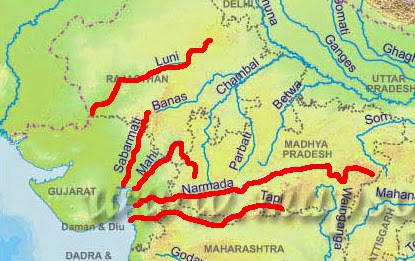
Estuary
- An estuary is a partially enclosed body of water along the coast where freshwater from rivers and streams meets and mixes with saltwater from the ocean. (Primary productivity in estuaries is very high. Fishing is a dominant occupation around estuaries. Most of the estuaries are good bird sanctuaries).
- Estuaries and the lands surrounding them are places of transition from land to sea and freshwater to saltwater.
- Although influenced by the tides, they are protected from the full force of ocean waves, winds, and storms by such landforms as barrier islands or peninsulas.
- Estuarine environments are among the most productive on earth, creating more organic matter each year than comparably-sized areas of forest, grassland, or agricultural land.
- The tidal, sheltered waters of estuaries also support unique communities of plants and animals especially adapted for life at the margin of the sea.
- Estuaries have important commercial value and their resources provide economic benefits for tourism, fisheries, and recreational activities.
- The protected coastal waters of estuaries also support important public infrastructure, serving as harbors and ports vital for shipping and transportation.
- Estuaries also perform other valuable services. Water draining from uplands carries sediments, nutrients, and other pollutants to estuaries. As the water flows through wetlands such as swamps and salt marshes, much of the sediments and pollutants are filtered out.
- Saltmarsh grasses and other estuarine plants also help prevent erosion and stabilize shorelines Mangroves.
Narmada River
- Narmada is the largest west flowing river of peninsular India.
- Narmada flows westwards through a rift valley between the Vindhyan Range on the north and the Satpura Range on the south.
- It rises from the Maikala range near Amarkantak in Madhya Pradesh, at an elevation of about 1057 m.
- Narmada basin extends over states of Madhya Pradesh, Gujarat, Maharashtra, and Chhattisgarh having an area ~1 Lakh Sq.km.
- It is bounded by the Vindhyas on the north, Maikala range on the east, Satpuras on the south, and by the Arabian Sea on the west.
- Its total length from its source in Amarkantak to its estuary in the Gulf of Khambhat is 1,310 km.
- The hilly regions are in the upper part of the basin, and lower-middle reaches are broad and fertile areas well suited for cultivation.
- Jabalpur is the only important urban center in the basin.
- The river slopes down near Jabalpur where it cascades (a small waterfall, especially one in a series) 15 m into a gorge to form the Dhuan Dhar (Cloud of Mist) Falls.
- Since the gorge is composed of marble, it is popularly known as the Marble Rocks.
- It makes two waterfalls of 12 m each at Mandhar and Dardi. Near Maheshwar, the river again descends from another small fall of 8 m, known as the Sahasradhara Falls.
- There are several islands in the estuary of the Narmada of which Aliabet is the largest.
- The Narmada is navigable up to 112 km from its mouth.
Tributaries of Narmada River
- Right bank tributaries are the Barna, Hiran River, Tendoni River, Choral River, Kolar River, Man River, Uri River, Hatni River, Orsang River
- Left bank tributaries – Burhner River, Banjar River, Sher River, Shakkar River, Dudhi River, Tawa River, Ganjal River, Chhota Tawa River, Kaveri River, Kundi River, Goi River, Karjan River
- The major Hydro Power projects in the basin are Indira Sagar, Sardar Sarovar, Omkareshwar, Bargi & Maheshwar.
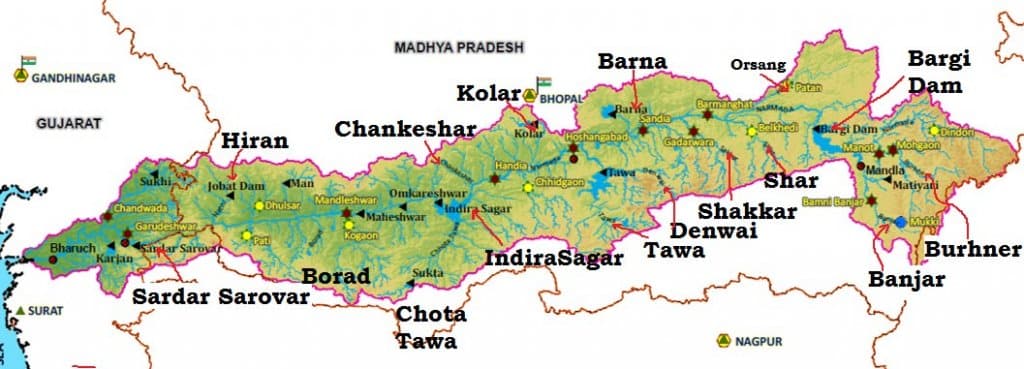
Tawa River
- The river rises from the Satpura Range of Betul in MP.
- This river is the longest tributary of River Narmada.
Tapti River
- The Tapti (also known as the Tapi) is the second-largest west flowing river of Peninsular India and is known as ‘the twin’ or ‘the handmaid’ of the Narmada.
- It originates near Multai reserve forest in Madhya Pradesh at an elevation of 752 m.
- Flows for about 724 km before outfalling into the Arabian Sea through the Gulf of Cambay [Gulf of Khambhat].
- The Tapti River along with its tributaries flows over the plains of Vidharbha, Khandesh, and Gujarat and over large areas in the state of Maharashtra and a small area in Madhya Pradesh and Gujarat.
- The basin extends over states of Madhya Pradesh, Maharashtra, and Gujarat having an area of ~ 65,000 Sq.km
- Situated in the Deccan plateau, the basin is bounded by the Satpura range on the north, Mahadev hills on the east, Ajanta Range and the Satmala hills on the south, and by the Arabian Sea on the west.
- The hilly region of the basin is well forested while the plains are broad and fertile areas suitable for cultivation.
- There are two well-defined physical regions, in the basin, viz hilly region and plains; the hilly regions comprising Satpura, Satmalas, Mahadeo, Ajanta, and Gawilgarh hills are well forested.
- The plain covers the Khandesh areas (Khandesh is a region of central India, which forms the northwestern portion of Maharashtra state) which are broad and fertile suitable for cultivation primarily.
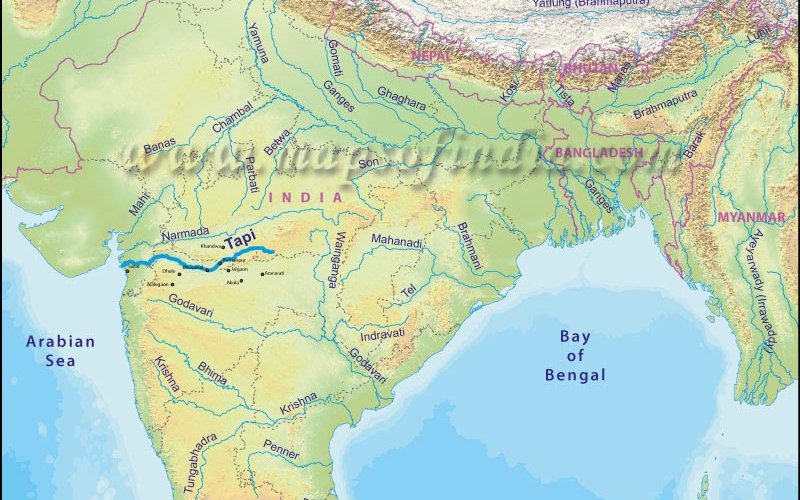
Tributaries of Tapti River
- Right Bank: the Suki, the Gomai, the Arunavati and the Aner.
- Left Bank: the Vaghur, the Amravati, the Buray, the Panjhra, the Bori, the Girna, the Purna, the Mona and the Sipna.
Projects on Tapti River
- Hathnur Dam of Upper Tapi Project (Maharashtra)
- Kakrapar weir and Ukai Dam of Ukai Project (Gujarat)
- Girna Dam and Dahigam Weir of Girna Project (Maharashtra)
Industry in the Tapti Basin
- Important industries in the basin are textile factories in Surat and paper and news print factory at Nepanagar.
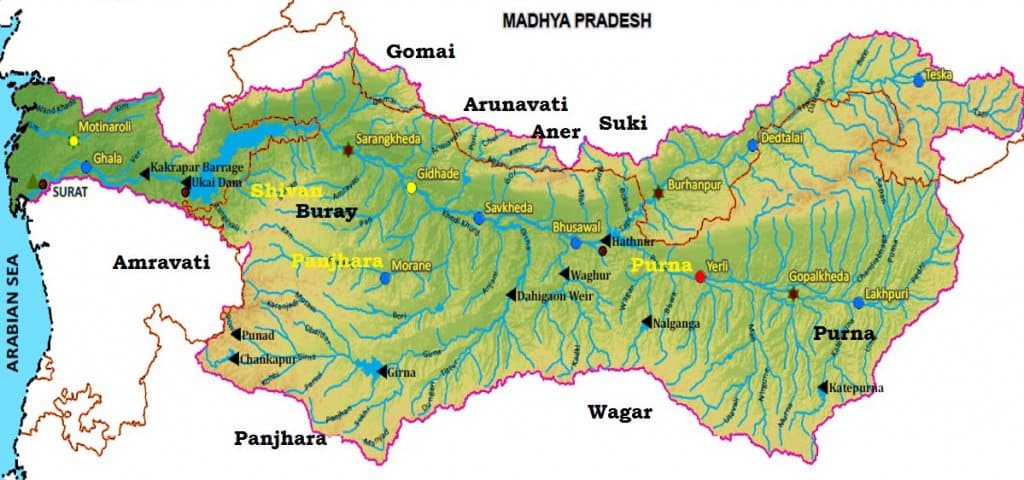
Sabarmati River
- The Sabarmati is the name given to the combined streams the Sabar and Hathmati.
- The Sabarmati basin extends over the states of Rajasthan and Gujarat having an area of 21,674 Sq km.
- The basin is bounded by Aravalli hills on the north and north-east, by Rann of Kutch on the west, and by the Gulf of Khambhat on the south.
- The basin is roughly triangular in shape with the Sabarmati River as the base and the source of the Vatrak River as the apex point.
- Sabarmati originates from Aravalli hills at an elevation of 762 m near village Tepur, in the Udaipur district of Rajasthan.
- The total length of the river from origin to outfall into the Arabian Sea is 371 km.
- The major part of the basin is covered with agriculture accounting to 74.68% of the total area.
- Rainfall varies from a meager few mm in Saurashtra to over 1000 mm in the southern part.
- Left bank tributaries: the Wakal, the Hathmati, and the Vatrak.
- Right bank tributaries: the Sei.
- Projects: Sabarmati reservoir (Dharoi), Hathmati reservoir, and Meshwo reservoir project are major projects completed during the plan period.
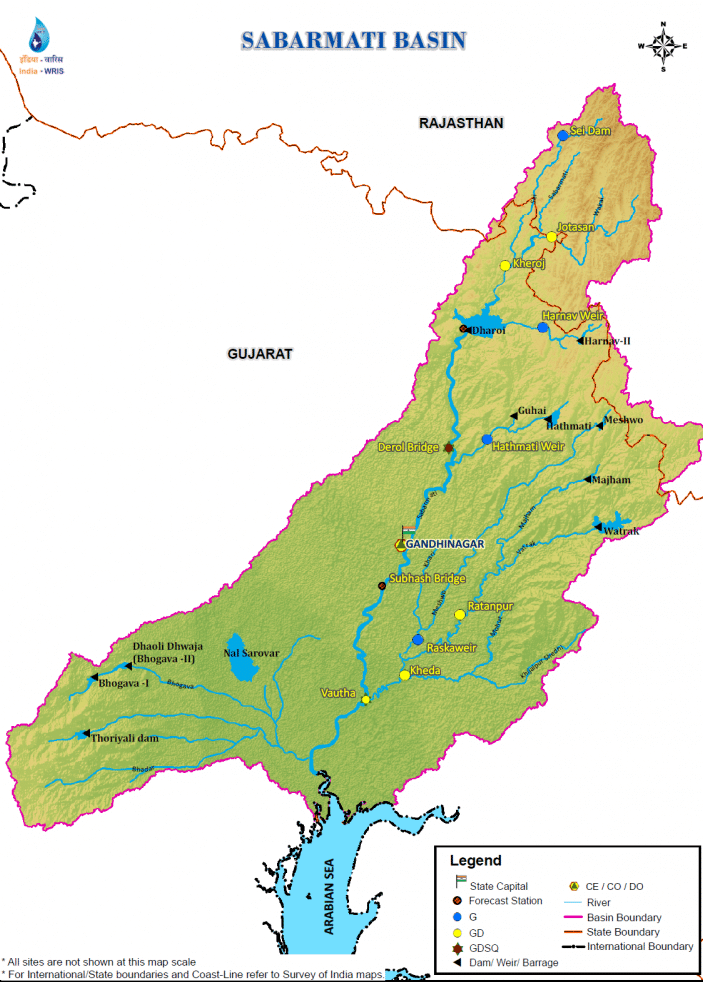
Industry in Sabarmati Basin
- Gandhinagar and Ahmedabad are the important urban centers in the basin.
- Ahmedabad is an industrial city situated on the banks of Sabarmati.
- Important industries are textiles, leather and leather goods, plastic, rubber goods, paper, newsprint, automobile, machine tools, drugs and pharmaceuticals etc.
- The industrial city of Ahmedabad poses the danger of water pollution.
Mahi River
- The Mahi basin extends over states of Madhya Pradesh, Rajasthan, and Gujarat having a total area of 34,842 Sq km.
- It is bounded by Aravalli hills on the north and the north-west, by Malwa Plateau on the east, by the Vindhyas on the south, and by the Gulf of Khambhat on the west.
- Mahi is one of the major interstate west flowing rivers of India.
- It originates from the northern slopes of Vindhyas at an altitude of 500 m in the Dhar district of Madhya Pradesh.
- The total length of Mahi is 583 km.
- It drains into the Arabian Sea through the Gulf of Khambhat.
- The major part of the basin is covered with agricultural land accounting to 63.63% of the total area
- Hydro Power stations are located – Mahi Bajaj Sagar dam, Kadana Dam, and Wanakbori dam (Weir).
- Vadodara is the only important urban centre in the basin. There are not many industries in the basin.
- Some of the industries are cotton textile, paper, newsprint, drugs, and pharmaceuticals. Most of these industries are located at Ratlam.
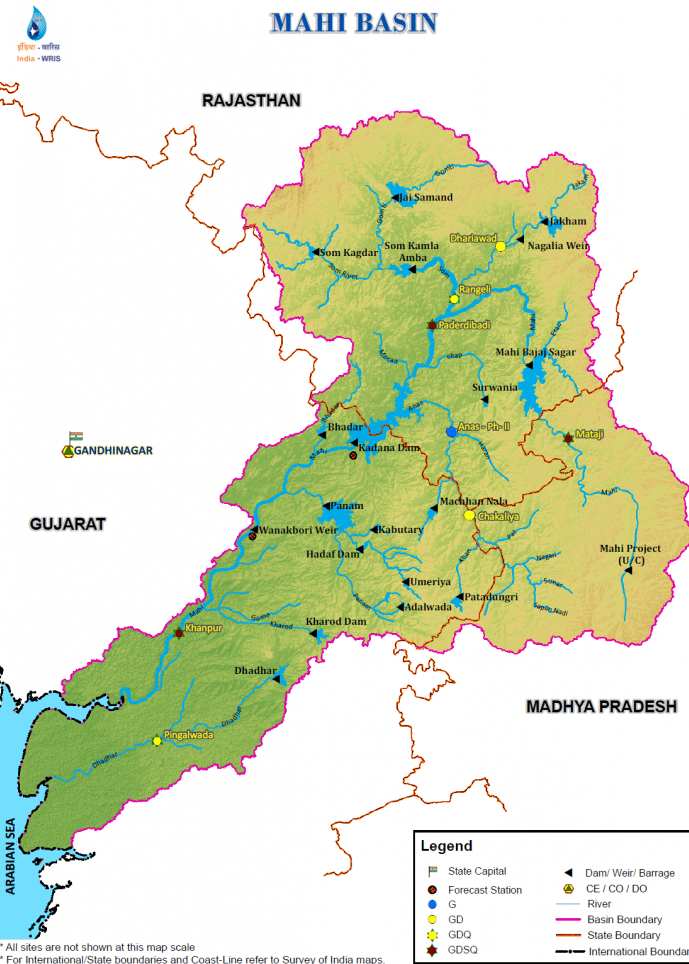
Tributaries of Mahi:
- Som
- This is the right bank tributary of Mahi. Som river rises near Som on the Eastern slopes of the Aravalli hills in the Udaipur district of Rajasthan at an elevation of 600 m above m.s.l. and flows in the Eastern direction to join the main river Mahi on the right bank 6.3 km upstream of Paderdibadi site in Dungarpur district of Rajasthan. Its total length is about 155 km. The total drainage area of Som is 8707 sq. km. Gomti & Jakham are the major right bank sub tributaries of Som.
- Anas
- This is a Left bank tributary of Mahi. Anas River rises near Kalmora on the Northern slopes of Vindhyas in Jhabua district in Madhya Pradesh at an elevation of 450 m above m.s.l. and flows in the North – West direction and joins the main river Mahi on the left bank in the Dungarpur district in Rajasthan. It has a total length of about 156 km and a total drainage area of 5604 sq. km.
- Panam
- This is a Left bank tributary of Mahi. Panam river rises near Bhadra on the Northern slopes of the Vindhyas near the Jhabua district in Madhya Pradesh at an elevation of about 300 m above m.s.l. and flows in the North – West direction and joins the main river on the left bank in the Panchmahal district of Gujarat. It has a total length of about 127 km and a drainage area of about 2470 sq. km.
Luni River
- The Luni or the Salt River (Lonari or Lavanavari in Sanskrit) is named so because its water is brackish below Balotra.
- Luni is the only river basin of any significance in Western Rajasthan, which forms the bulk of the arid zone.
- Luni originates from the western slopes of the Aravalli ranges at an elevation of 772 m near Ajmer flowing in the southwest direction and traversing a course of 511 km in Rajasthan, it finally flows into the Rann of Kachchh (it gets lost in the marsh).
- Most of its tributaries drain the steep northwest of Aravalli hills and join it on the left side. Its total catchment area falls in Rajasthan.
- The peculiarity of this river is that it tends to increase its width rather than deepening the bed because the banks are of soils, which are easily erodible whereas beds are of sand. The floods develop and disappear so rapidly that they have no time to scour the bed.
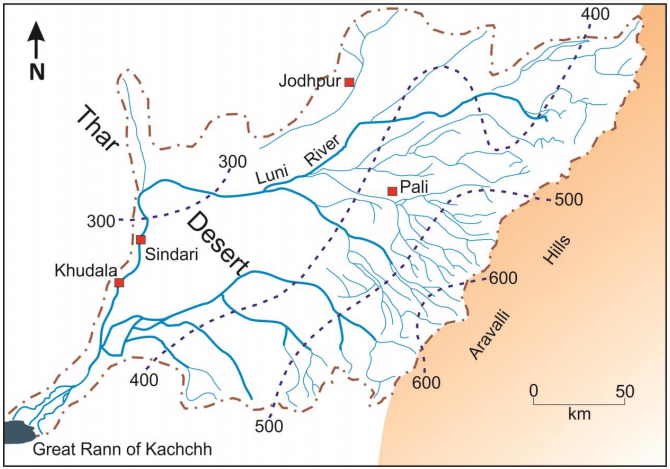
West flowing Rivers of the Sahyadris (Western Ghats)
- About six hundred small streams originate from the Western Ghats and flow westwards to fall into the Arabian Sea.
- The western slopes of the Western Ghats receive heavy rainfall from the south-west monsoons and are able to feed such a large number of streams.
- Although only about 3% of the areal extent flow swiftly down the steep slope and some of them make waterfalls.
- The Jog or Gersoppa Falls(289 m) made by the Sharavati river is the most famous waterfall of India.
- Sharavati is a river which originates and flows entirely within the state of Karnataka.
Ghaggar River – Inland Drainage
- Some rivers of India are not able to reach the sea and constitute inland drainage.
- Large parts of the Rajasthan desert and parts of Aksai Chin in Ladakh have inland drainage.
- The Ghaggar is the most important river of inland drainage. It is a seasonal stream that rises on the lower slopes of the Himalayas and forms the boundary between Haryana and Punjab.
- It gets lost in the dry sands of Rajasthan near Hanumangarh after traversing a distance of 465 km.
- Earlier, this river was an affluent of the Indus, the dry bed of the old channel is still traceable.
- Its main tributaries are the Tangri, the Markanda, the Saraswati and the Chaitanya.
- It contains a lot more water in the rainy season when its bed becomes 10 km wide at places.
- Most of the streams draining western slopes of the Aravalli Range dry up immediately after they enter the sandy arid areas to the west of this range.
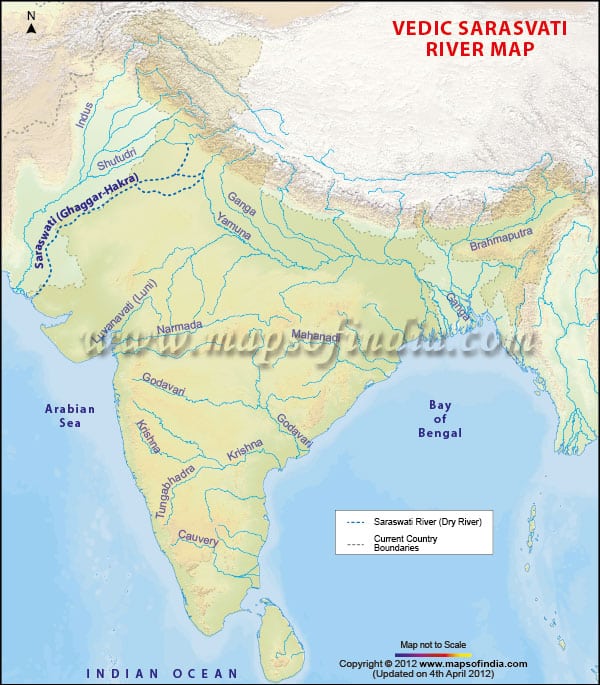
Mhadei river
- Mahadayi or Mhadei, the west-flowing river, originates in Bhimgad Wildlife Sanctuary (Western Ghats), Belagavi district of Karnataka.
- It is essentially a rain-fed river also called Mandovi in Goa.
- It is joined by a number of streams to form the Mandovi which is one of two major rivers (the other one is the Zuari river) that flows through Goa.
- The river travels 35 km in Karnataka; 82 km in Goa before joining the Arabian Sea.
- Kalasa-Banduri Nala project
- Undertaken by the Government of Karnataka to improve drinking water supply to the Districts of Belagavi, Dharwad, and Gadag. It involves building across Kalasa and Banduri, two tributaries of the Mahadayi river to divert 7.56 TMC of water to the Malaprabha river.
- Kalasa-Banduri project was planned in 1989; Goa raised an objection to it.
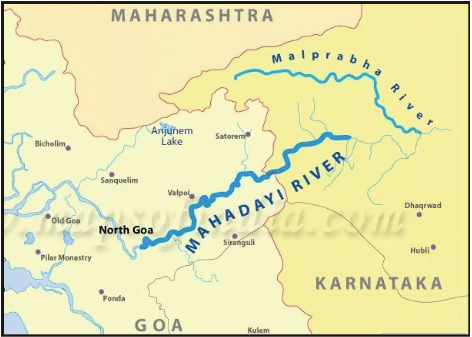
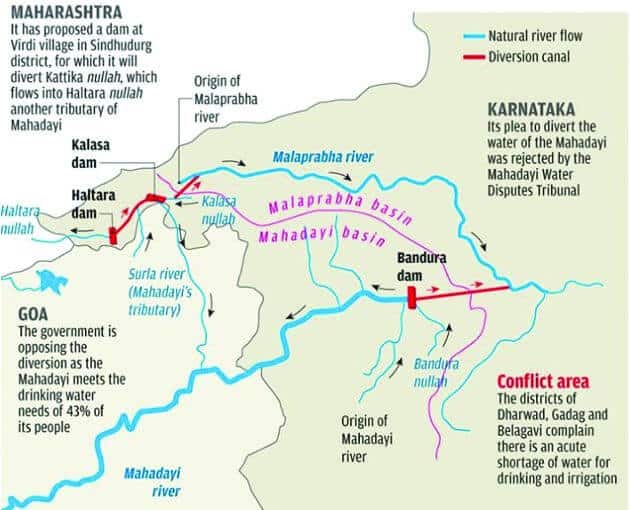
Usability of Rivers
- Source of fresh water, irrigation, hydro-electric production, navigation, etc.
- The Himalayas, Vindhyas, Satpuras, Aravalis, Maikala, Chhotanagpur plateau, Meghalaya plateau, Purvachal, Western and the Eastern Ghats offer possibilities of large scale water power development.
- Sixty percent of the total river flow is concentrated in the Himalayan rivers, 16 percent in the Central Indian rivers (the Narmada, the Tapi, the Mahanadi, etc.), and the rest in the rivers of the Deccan plateau.
- The Ganga and the Brahmaputra in the north and northeastern part of the country, the Mahanadi in Odisha, the Godavari and the Krishna in Andhra and Telangana the Narmada and the Tapi in Gujarat, and the lakes and tidal creeks in coastal states possess some of the important and useful waterways of the country.
- In the past, they were of great importance, which suffered a great deal with the advent of rail and roads.
- Withdrawal of large quantities of water for irrigation resulted in the dwindling flow of many rivers.
- The most important navigable rivers are the Ganga, the Brahmaputra, and the Mahanadi. The Godavari, the Krishna, the Narmada, and the Tapi are navigable near their mouths only.

Great Compailation..Sir Please provide Economic & History notes also
Yeah Sure, will do
if possible please provide commerce and accountancy optional notes
REALLY HELPFULL
the numerical % of narmada basin in indian states is missing here…but still is content is far better than all other sites